Fall is one of my favorite times for gathering wild food and medicine, and foraging rose hips has a lot to do with that! Wild rose and rose hips are foraged at different times of the year, with rose hip season beginning in the autumn. This post will look at both the flowers and the fruit of members of the rose family, so keep the blooms in mind for the spring if you’re reading about rose hips in the fall.
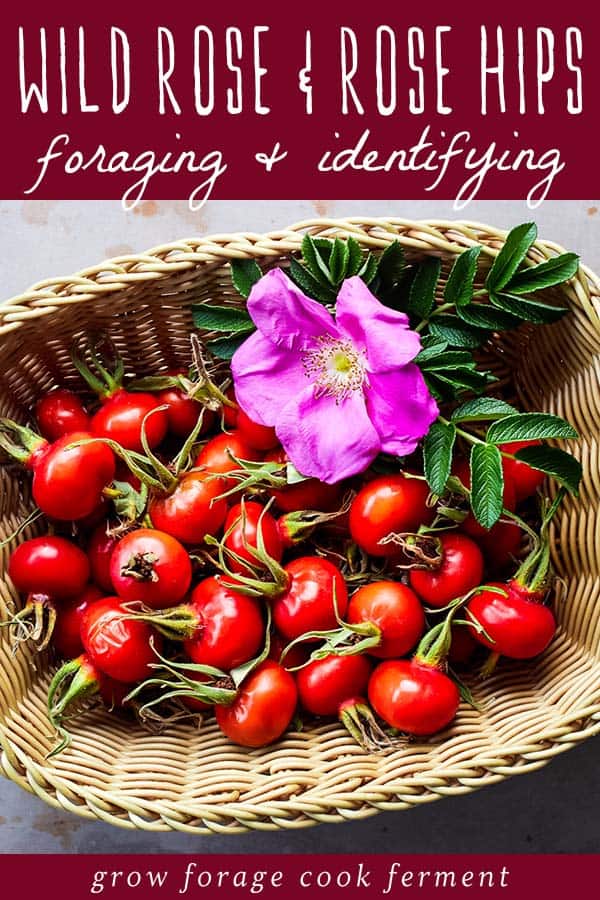
Want to save this post for later?
Wildcrafting Weeds
If you want to learn more about the edible and medicinal weeds that surround us and how to use them, check out my eBook: Wildcrafting Weeds: 20 Easy to Forage Edible and Medicinal Plants (that might be growing in your backyard)!
About Wild Rose & Rose Hips
Roses are members of the Rosa spp., of which there are over 300 different types of wild and cultivated species.
Although I will be focusing on foraging for wild roses and rose hips, cultivated roses that haven’t been sprayed with chemicals share all the same benefits and uses as their wild counterparts.
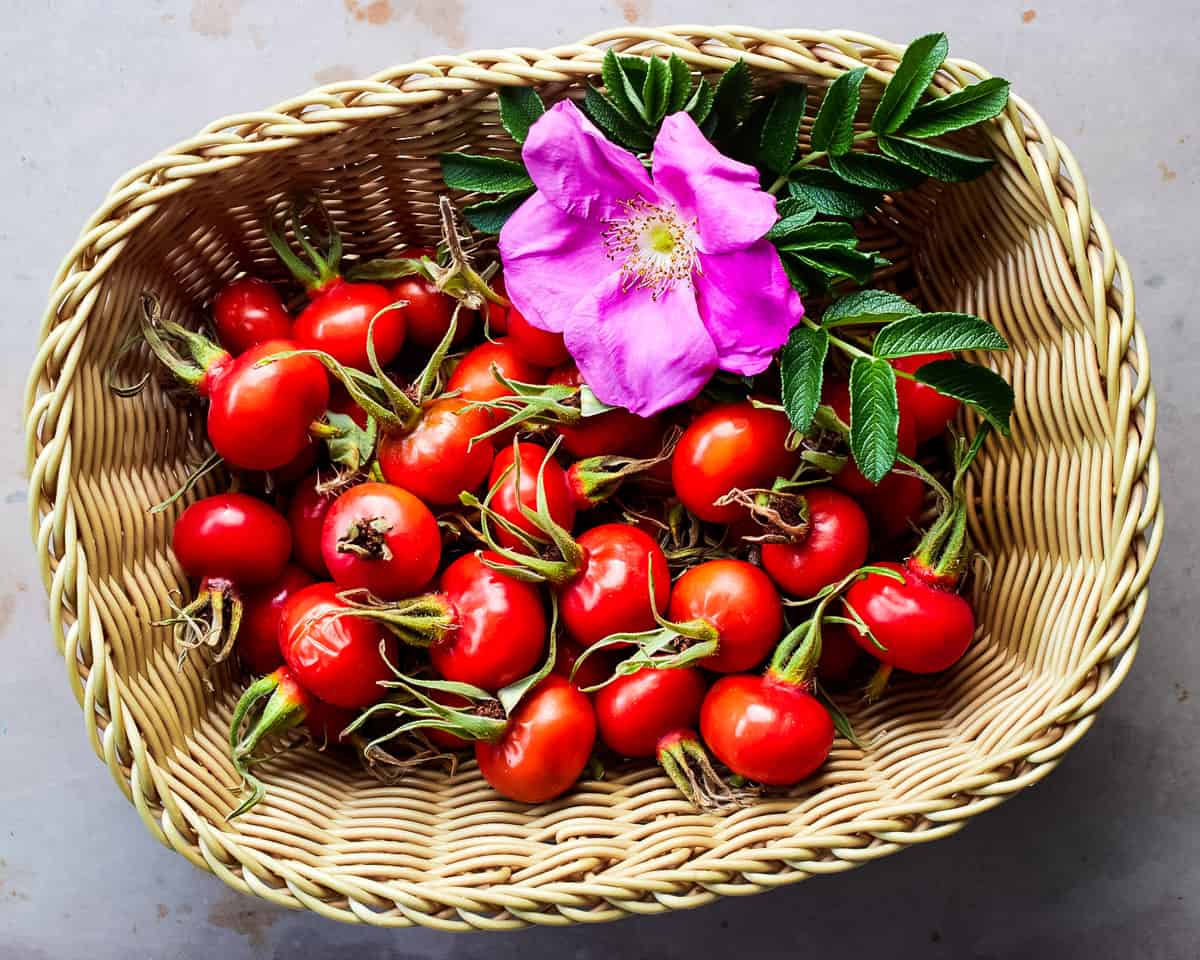
Where and When to Find Wild Rose
From the Australian outback to Northern Canada, species of wild rose can be found worldwide in a wide variety of natural habitats.
Wild roses typically grow in fields, disturbed areas, or thickets as well as along woodland edges, roadsides, and trails.
Wild rose flowers bloom in the spring and summer, while rose hips begin to appear in early autumn and throughout the winter.
If you have your own rose bushes just remember that hips will only form where the flower was, so don’t cut all of the flowers if you want rose hips.
When to Find Rose Hips
Rose hips are the fruit of the rose plant and appear after the blooms have dropped from the plant. Rose hips ripen in the fall and throughout early winter.
If you live where winters are milder you may be able to harvest rose hips well into the winter season.
Learn more about year round foraging in my guides about fall foraging and winter foraging!
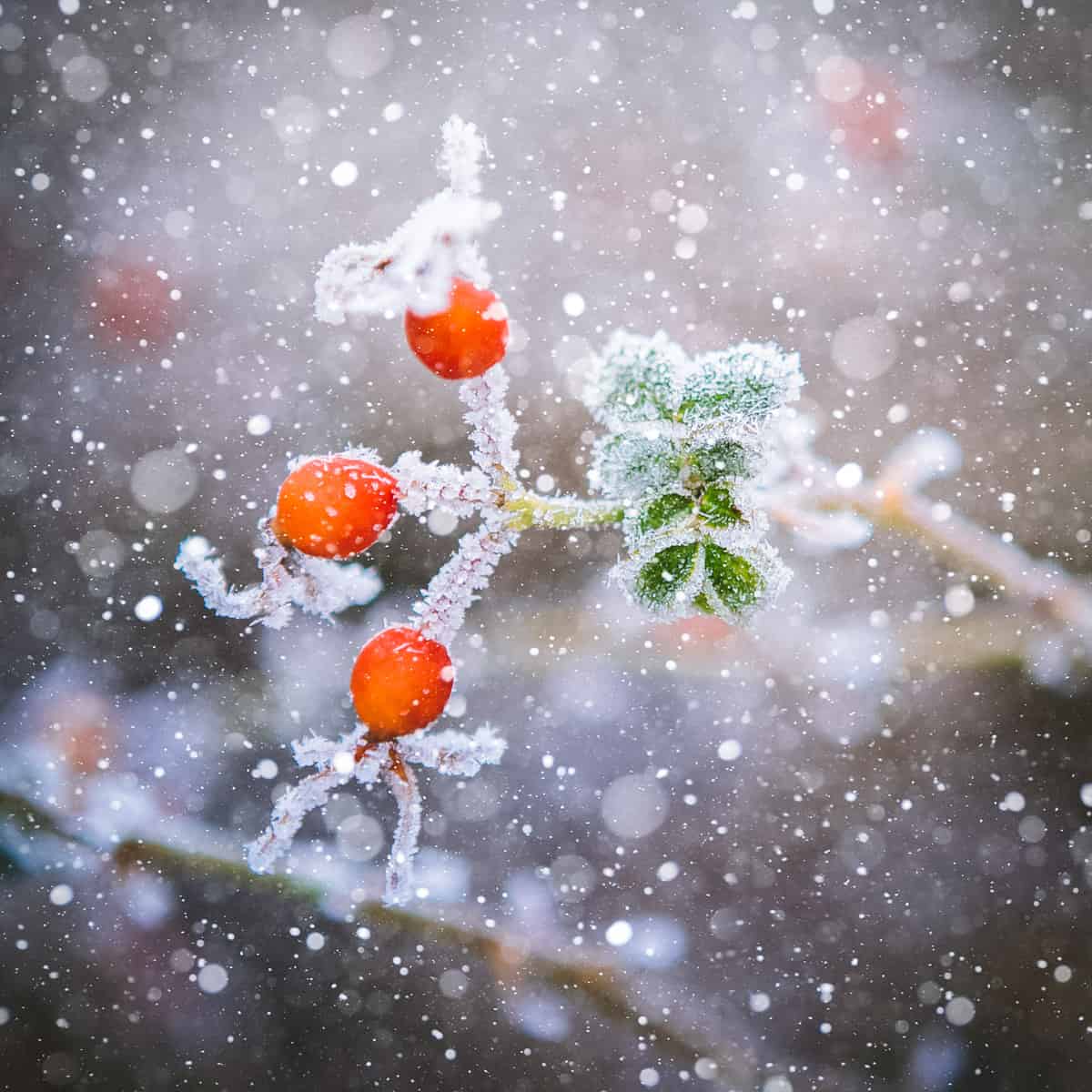
Identifying Wild Rose
Considering how many hundreds of rose species there are growing in the wild, it can sometimes be difficult for a beginner forager to differentiate between one type of flower and another.
However, there are a couple of common features that help with the identification process. All roses have curved thorns and alternate, pinnate leaves with 3-9 leaflets; the flowers are symmetrical and are typically pink or white.
Some species of wild rose, such as multiflora rose (Rosa multiflora) and dog rose (Rosa canina) are climbing vines. Other varieties, such as Virginia rose (Rosa virginiana) or rugosa rose (Rose rugosa) are more shrub-like in appearance.
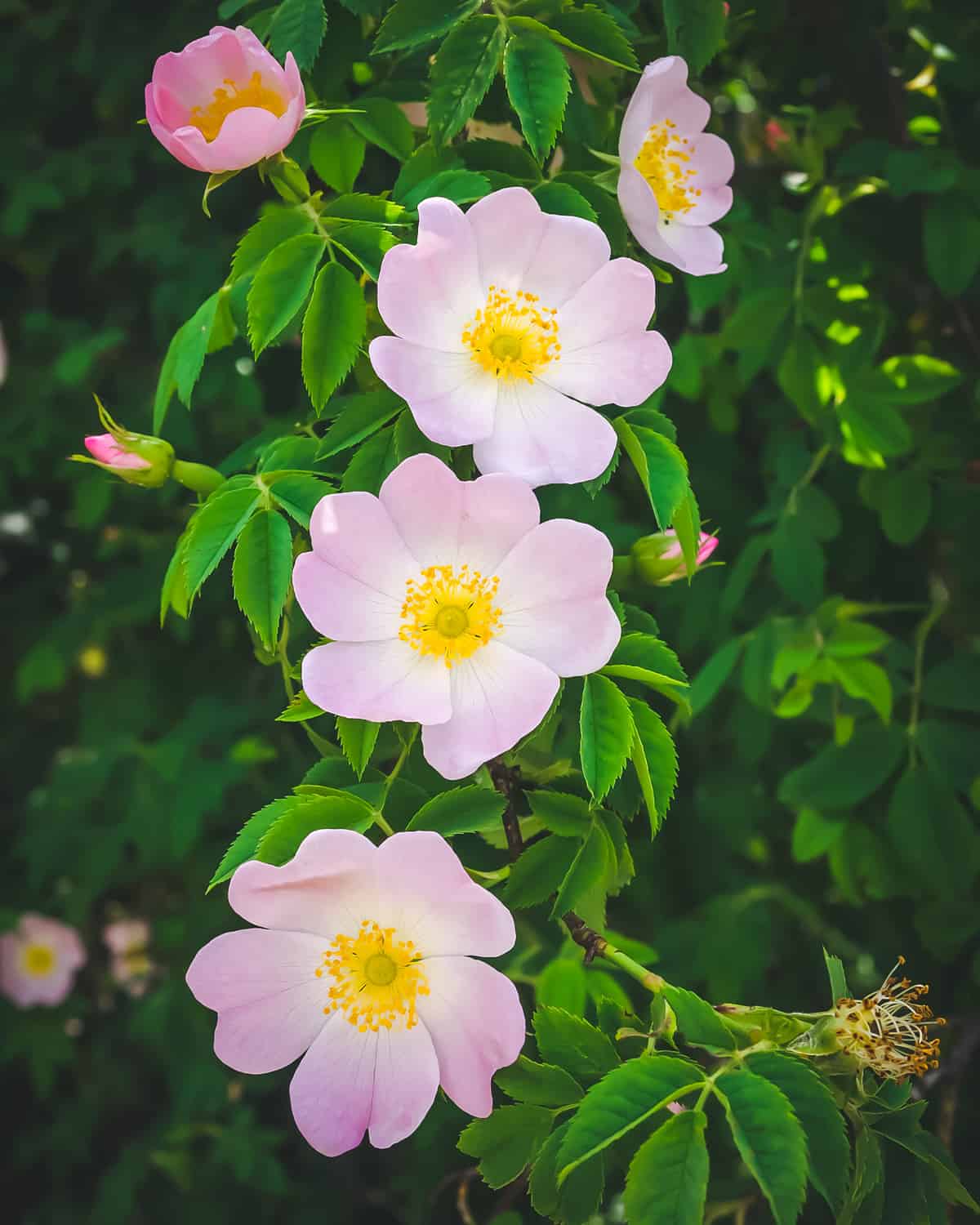
Identifying Rose Hips
Rose hips are the fruit of roses, replacing the freshly fallen flowers when the temperature begins to grow colder.
They are red to orange in color, oblong or round in shape, often with small wisps of “hair” protruding from the bottom of the rose hip.
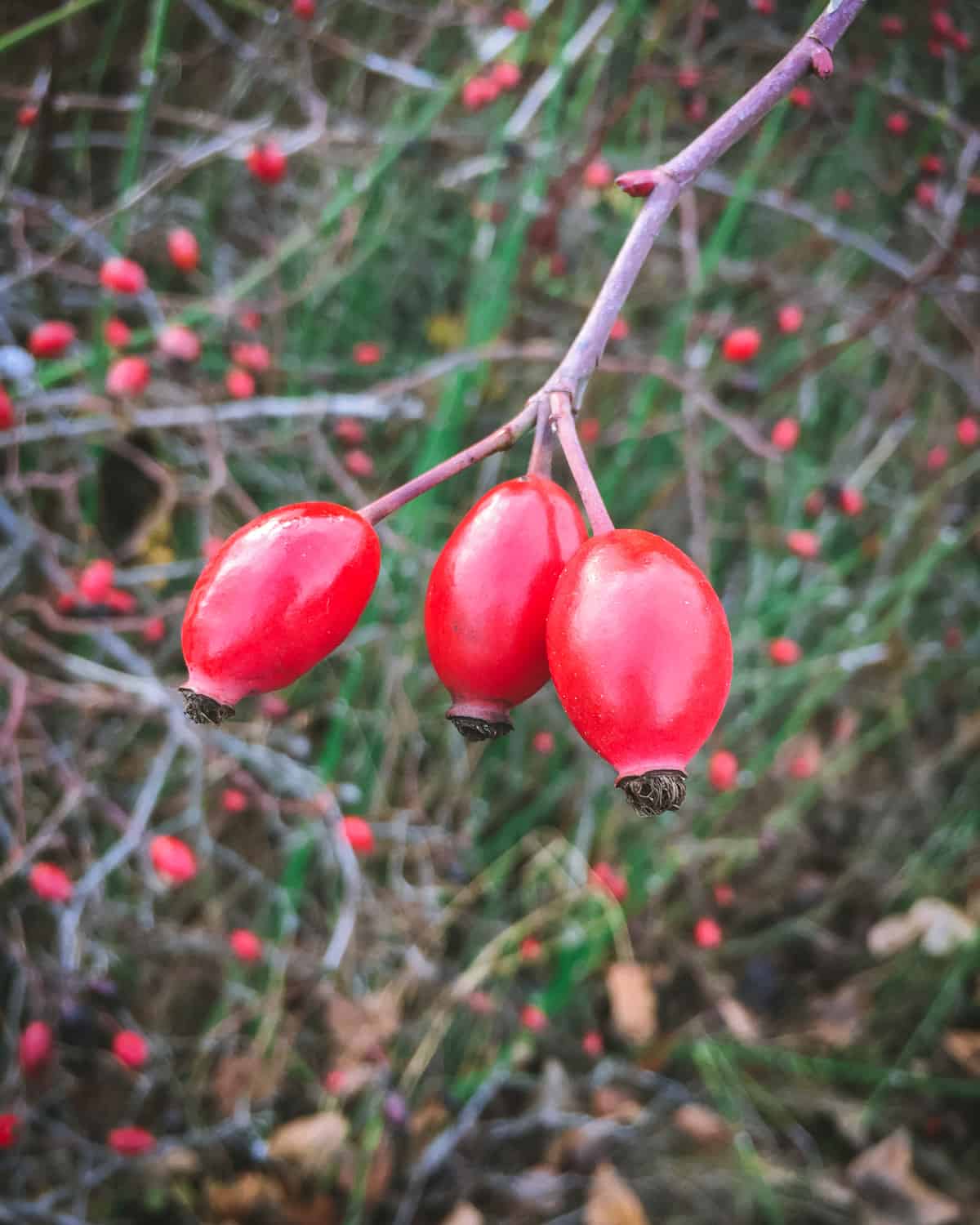
Rose hips come in all shapes and sizes, from large to small. Some rose hips, such as those from the dog rose, are more oblong in shape.
Others are large and round, such as those from the rugosa rose.
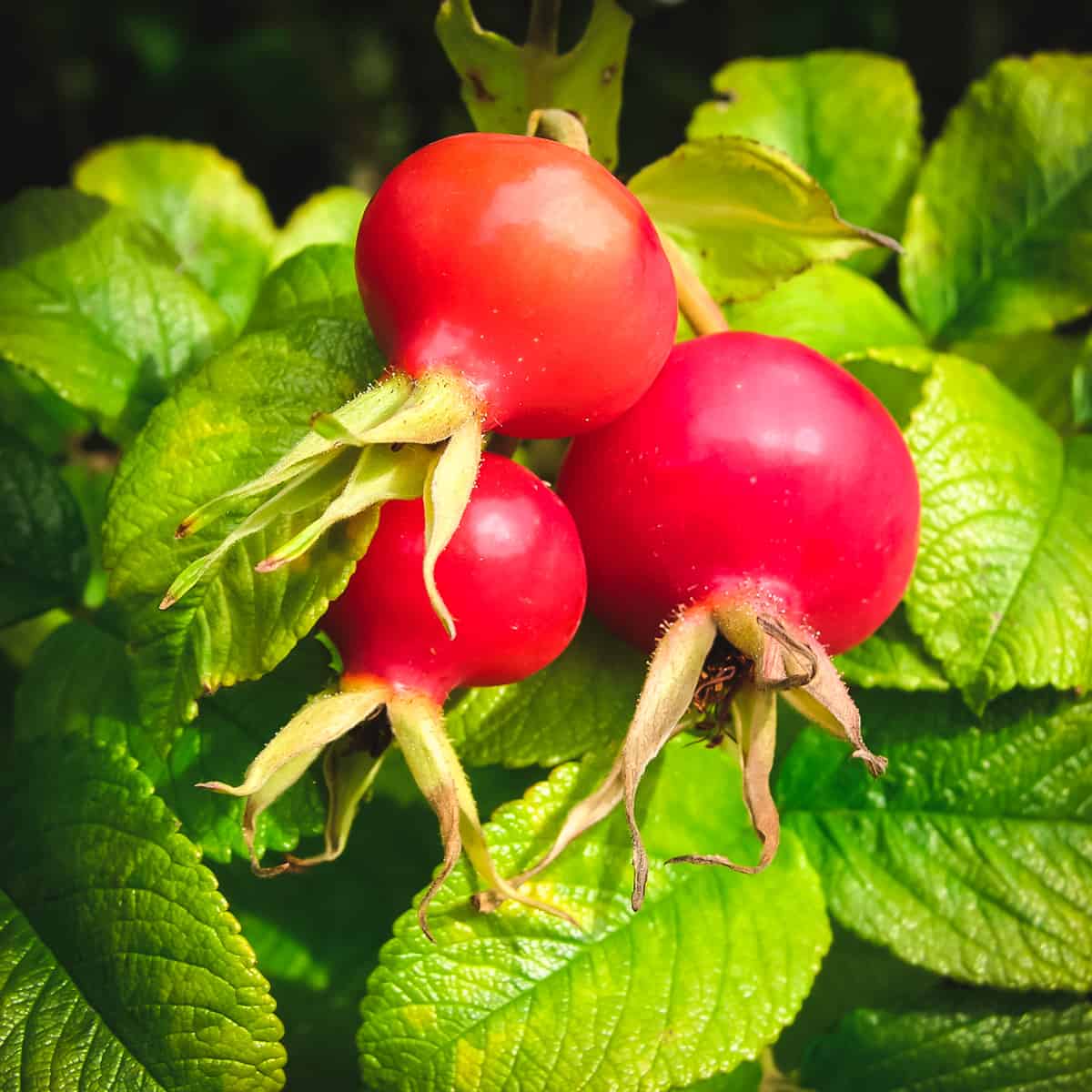
Harvesting Wild Rose
When harvesting wild or cultivated roses, look for newly opened blossoms whenever possible. The flowers should be fresh and fragrant, without showing signs of wilting. A sturdy pair of gardening gloves will protect you from any painful pricks caused by thorns.
Once the roses have been harvested, they can be dried whole or separated into individual petals. I use my handmade flower drying screen but any version, store-bought or otherwise, is incredibly useful for drying purposes.
As with any foraging project, make sure the area you’re covering hasn’t been sprayed with chemicals (including those picked in your own backyard!).
Avoid using commercially cultivated roses, as they have almost certainly been sprayed with chemicals to preserve their appearance.
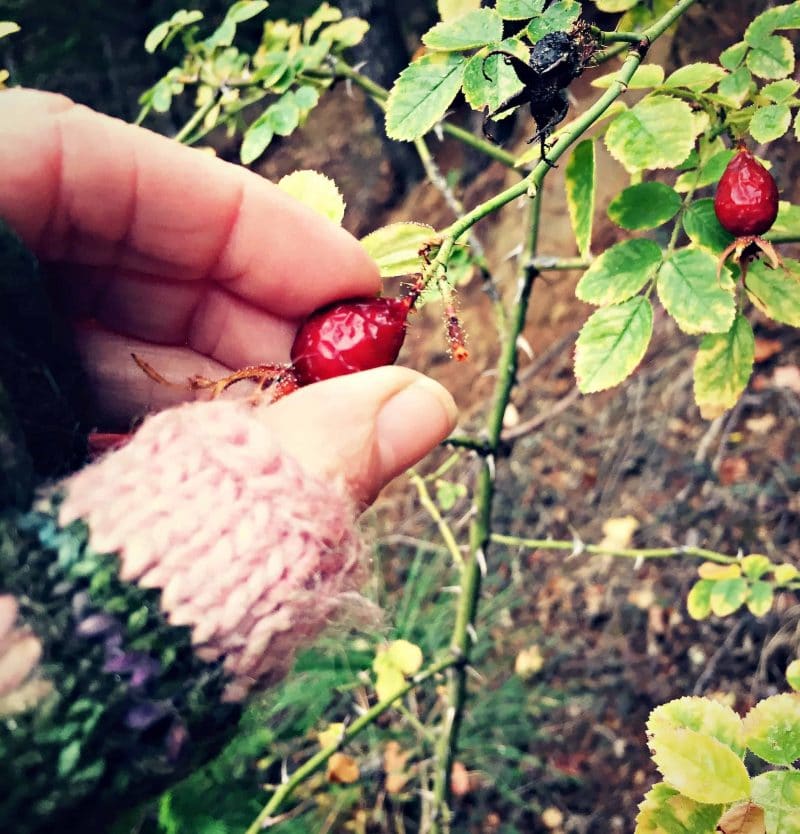
Harvesting Rose Hips
Begin harvesting rose hips in the fall, the longer the rose hips grow on the plant the sweeter they become. It’s ok if they are a bit wrinkly!
Look for red to orange (no green) rose hips that easily detach from the stem, you shouldn’t have to tug much to harvest them. Just like with wine grapes, rose hips become sweeter and more flavorful if they’re exposed to frost before being harvested.
All rose hips from any type of rose, even cultivated varieties, are edible and full of nutrients and have numerous medicinal uses.
Once harvested, rose hips can be used fresh, kept frozen, or dried in a dehydrator or on a drying screen. Large rose hips can be cut open to remove the seeds and irritating hairs before drying, if you prefer.
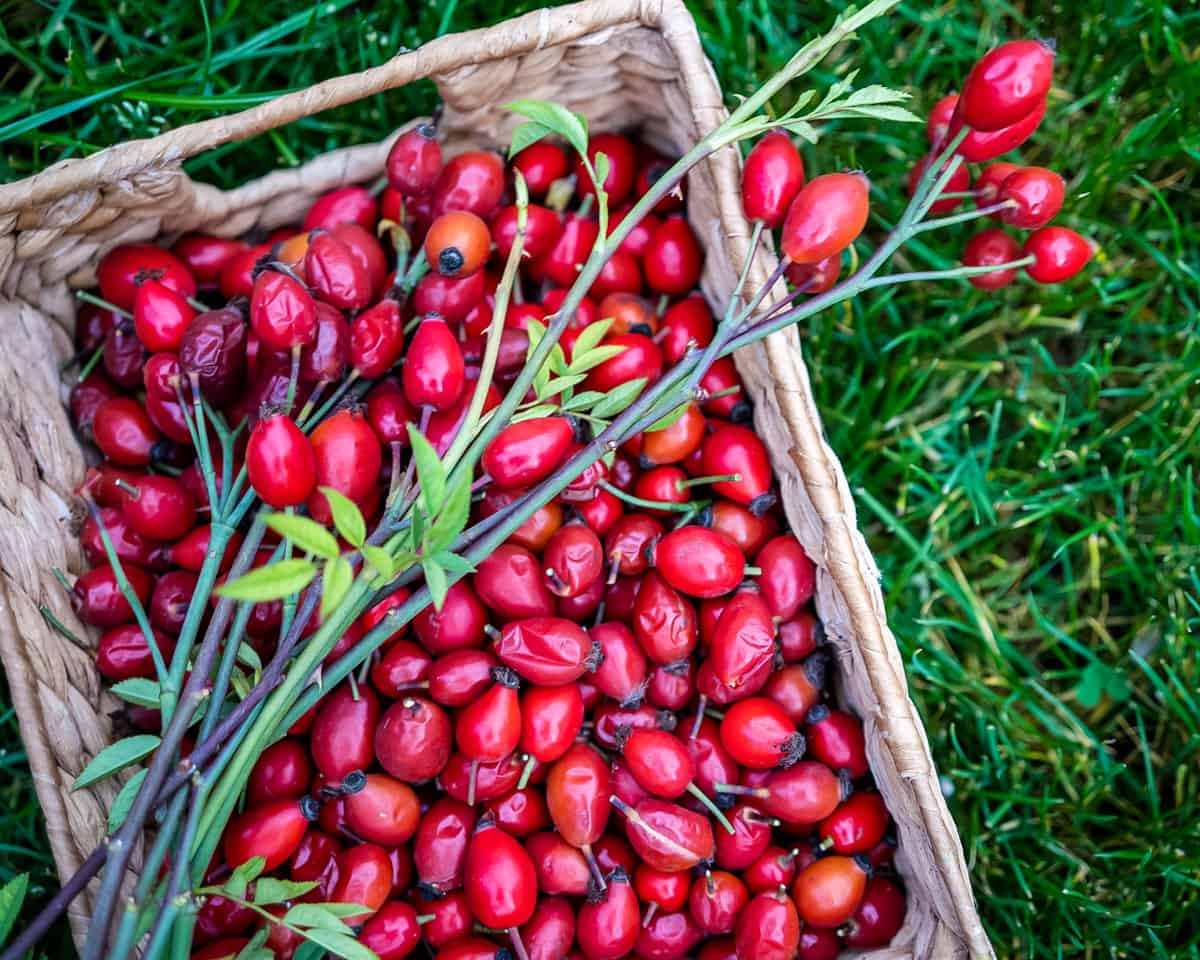
Wild Rose & Rose Hip Look-alikes
Wild roses (and cultivated roses) have no toxic look-alikes, which makes them ideal for the beginner forager. While there are some ornamental flowers which are similar in appearance to wild roses, they don’t pose any kind of health threat.
There really aren’t any rose hip look-alikes, especially if you know that they came from a rose plant. They can sometimes resemble hawthorn berries, which are not toxic and have edible and medicinal uses as well.
Edible Uses of Wild Rose
High in flavonoids and antioxidants, rose petals make elegant and colorful additions to salads and desserts (especially sugared roses, which always look so beautiful).
I’m particularly keen on homemade rose petal jelly (add a teaspoon to sparkling wine or pair it with a mild soft cheese and a baguette) and I can never have enough good things to say about making rose water from fragrant rose petals.
Looking for other ways to enjoy a floral harvest? Rose petals can be used to infuse honey, mead, vinegar, wine, and liquors.
Edible Uses of Rose Hips
Rose hips are one the highest plant sources of vitamin C, particularly when eaten fresh or as minimally processed as possible. Ripe rose hips have a tart and sweet flavor similar to crab apples (which isn’t surprising, as they’re in the same family!).
Rose hips have threadlike hairs inside and around the seeds that can be irritating to the throat and stomach if ingested. Before serving anything made with rose hips make sure to pass it through a coffee filter, several layers of cheesecloth, or another equally fine material.
If you will be consuming whole rose hips in something that cannot be strained, such as in cookies or jam, be sure to cut them open and scoop out the seeds and irritating hairs before using. This is easiest with larger rose hips.
The flavor of rose hips is right at home in cocktails and other libations, like this recipe for a rose hip whiskey smash. You can also make a rose hip shrub, which can be added to kombucha or cocktails as desired.
For more rose hip-related inspiration, check out my post with over 60 rose hip recipes!
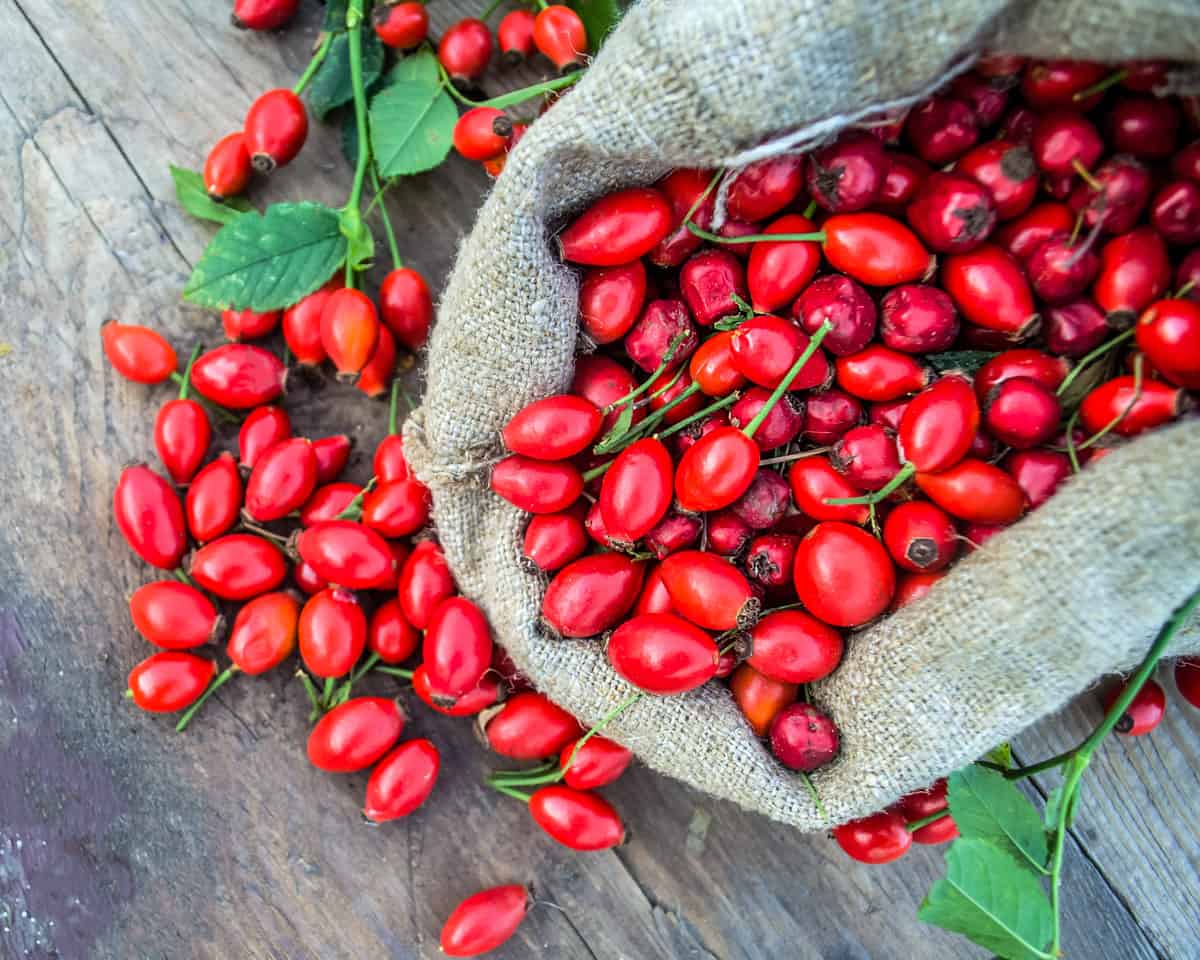
Medicinal Uses of Wild Rose
There’s a good reason why roses show up so often in skin care (other than their gorgeous floral scent), rose petals are cooling, astringent, anti-inflammatory, and antimicrobial. Use them in skin-soothing rose lotion bars, rose petal salve, rose hip facial oil, or wild rose and yarrow soap.
Those same healing properties can also boost the immune system during cold and flu season and can help digestive upset when taken as a tonic.
Rose petals are safe for children to consume, and can easily be made into tea or gummies to be taken at the onset of symptoms.
Medicinal Uses of Rose Hips
Rose hips are considered highly medicinal thanks to a potent combination of vitamin C and antioxidants, which is why I like to include them when making my immune-boosting herbal tea blend or a simple cup of rose hip tea.
Rose hips are perfect to use in homemade syrup or you can infuse them into honey, oil, vinegar, or even alcohol to utilize their medicinal benefits. See my recipe for an infused wine with reishi mushrooms and rose hips.
Rose hip seed oil is a gentle and soothing moisturizer for dry skin, one of the many reasons I like to add it to my homemade rose hip soap, rose hip face serum and lip balm for soothing dry lips.
Where to Buy Dried Rose Hips & Rose Petals
If you can’t find any wild rose or rose hips, or if they’re not in season, you can always buy dried rose petals or dried rose hips from Mountain Rose Herbs (my favorite place to buy high quality, organic herbs).
Foraging for rosehips and wild rose is easy and rewarding. I hope you found this post helpful in your wildcrafting adventures!

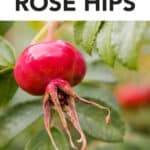


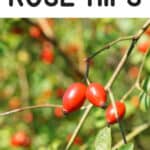
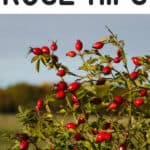
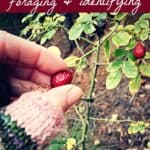
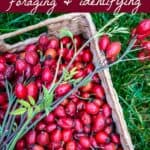




Can you propagate new plants from the seeds once they’re removed from the fruits?
Yes, you can. I haven’t tried it myself, but it looks like there are plenty of resources around the internet for growing roses from seed.
hola toda las rosas son comestibles
Yes, they’re all edible as long as they’re not sprayed with pesticides.
Rosehip is a vitamin C, a supplement for colds and flu. The jam and rosehip jam are very tasty.
Thanks Colleen
You’re welcome, Nenad!
Hi from Spain! I’ve never heard about eating roses seeds as food… But here is said that hips help you if you suffer from diarrhea.
All you write about is really interesting, congratulations!
Thank you so much. I’m glad you are enjoying it, Leta!
Hello, I wanted to make rose hip oil. I picked and dried the rosehips but dont know where to go from here. Do you know what i would do next to make a rose hip oil? I have read how good it is for your skin. I really enjoy your emails. Ii hope in time to know half of what you know. I find foraging so interesting. Sometimes I think i should have been born a bear, ha ha
Rosehip oil, which is produced commercially, extracts the oil from the seeds within the hip. Since that’s not really a viable option to DIY, you can make rosehip infused oil. I talk about how to do that in my rose hip lip balm post.
I have thoroughly enjoyed this article! I have several roses that I have planted many moons ago and I also have three bushes that are wild roses that my husband dug up and brought home. I will have to watch for these next year, where I live is cold now and we’ve had a little snow so I don’t know that any of mine would be good. Again, I appreciate all your information, I’ve also been reading your articles on Pine needle tea, how interesting! How wonderful to learn this knowledge that has been lost! Keep up the good work!
Thanks, Paula! I hope you enjoy your rose hips!
Appreciated the article! My rose hips are partially red and partially orange, not all pretty red like yours but we are nearing our first hard frost so I am wondering if they are ripe?
Yes, they likely are. I forage for them when they’re slightly soft before or after the first frost.
I always wonder the same thing: Can we pick rose hips from any rose bush, or are there specific or recommended varieties to pick the rose hips for tea and the benefit of vitamin C. Can you guide me on this? Thank you in advance.
We’ve picked a lot of ripe rose hips. I’ve washed them and removed the stems and leaves. Do I really have to remove all of the blossom frills and all the seeds before boiling them and straining them for juice ???
Hi Kay! No you don’t need to remove them before boiling, just make sure you use a fine mesh sieve lined with a coffee filter to strain out all of the hairs.
Thanks for the info. Just wondering if all rose hips have tiny hairs that cover the seeds? And when using rose hip, do you remove the seed and hairs before proceeding with: tea or drying or whatever use you are using it for?
Thank you
I”m a little late to the party here, but if the rosehips are red mid-august, can I use them this early or should I wait for a frost to make them sweeter? Sometimes if I wait until a frost, they get mushy or soggy very quickly. I live in the northeast (NY state) thanks
I’m having the same dilemma here in ontario. I picked some yesterday that look ripe and ready. How did your experience turn out?
Foraging for wild rose hips is a big thing in Alaska where I live. We wait till after the first hard frost to harvest. I’ve made syrup and powder for tea. A lot of people make jelly too
Are the hips from all roses edible, or only certain varieties? I’d love to use the hips from the bush in my yard, but I know nothing about it’s variety. Thanks for any help!
Yes all rose hips are edible, the variety doesn’t matter!
I have no idea when to harvest rose hips. What is the best time of year to harvest them? We live up in the northern Midwest where snow comes fairly early. We grow roses and only a few of our plants have grown the hips. I usually order them dried, but this is the first time I thought I would try getting them before the snow. Thank you! :)
Fall is generally the best time, and they will persist during freezing temperatures for a while too.
I normally make Rosehip vodka, but this year I am gently dehydrating them with some haws and elderberries to keep for making tea when I am not feeling 100% this winter :)
Where I live they grow by the millions. ..rugosa..near the ocean. They are really not gathered much by foragers, so I am fortunate…I will keep looking for information…for their use.
Do not forget the animals if you take these beautiful productschap from nature. If food is Scarce to find for you iT wil be scarse for them as well
In your picture, you just add whole rosehips to your tea. Do you still strain the hair out?
Can you use Green Rose hips for anything? I first found out of Rose hips at a prim mall! They used them for potpori.
I always wait until they are red, so I’m not sure!
In Sweden, where I come from we make rosebud soup. You can even buy it premade at the store. It’s sweet and full of vitamin c. To make it even better you can put a scoop of ice cream and almond biscuits in it right before you eat it.
I live in a town in Ohio. I’ve never noticed any berries (rosehips) on any rosebushes that I can remember. So all rosebushes have some type of rosehips? Are there any wild rosebushes around my area (Spfld)?
Im years late to your question, but I live in ohio an we have wild rose that gets small rose hips. I believe they are called miltiflora roses. The flowers are white or pink with a yellow center. They have 5 petals and do not look like a normal garden rose. They are quite invasive and usually around most wooded areas. I dont mind edibles growing on our property so I just leave them be.
Would you ferment rose hips in honey? Something like fermented honey garlic recipe. But don’t want to do mead, something for busting kids immune system. Thnx in advance. Iva
You could definitely try, but the honey would need a small amount of liquid to get the ferment going. I’m not sure if rose hips would have enough on their own.
Hi Colleen. I’m living in ireland and there are rose hips everywhere but I’ve never used them. Yet. :)
I’m just wondering if all rose hips are usable. There seem to be a lot of different ones growing wild around where I am.
I’ve also heard that straining them through muslin is very good for getting rid of the fibres. And I have experienced those fibres down my back many moons ago!!!!! Not good!!! :)
As long as they are rose hips, they are useable. I would get a local foraging book just to be sure. And yes, straining the hairs is a must!
Hi Sarah – I’m also living in Ireland and recently foraged beautiful rosehips from near Killiney beach in Dublin! They were the smaller variety. I made rosehip syrup from them and used a plant milk (nut bag) to strain the cooked syrup. The colour and flavor are beautiful! The recipe suggested freezing them overnight to simulate frost!
The proportions were 1000g of hips, 1000ml water and 500g sugar. Bring the berries, half the water and sugar to the boil. Simmer for about 15 mins. Strain. Then add the berries back into the pot with the remainder of the water. Repeat, then strain carefully. Now simmer the liquid again until it thickens slightly. Pour into sterilised jars. Lovely on ice-cream, pancakes or yoghurt! Hope this helps.
I forgot to mention that I roughly chopped them in a food mixer first!
I like the idea of freezing them to stimulate a frost. I’ve picked 2 cups and I’m in Ontario so we have not had any frost like conditions yet but the hips are ready.
i foraged and used some during winter (we are just leaving winter here), but found it impossible to cut them and get rid of the itchy fibres. is there a trick to this?
Boiling them and straining through a fine sieve seems to be the preferred method.
I know some rose hips are ripe when red. But I have also heard that you should wait until they are dark, almost black, to pick them. Can you please clarify? Thanks!
I’ve never heard of that and always pick them when red. They seem just fine to me!
In looking at your photos, I was drawn to the magnificent ruby red color of the rosehips. It looks like the color of the tea is quite lovely too (although I can’t tell for sure because the cup is opaque). I suppose, though, you could get a deeper shade of tea by using more rosehips. Which leads me to my question..
I’m wondering if anyone has tried using rosehips as a dye for fabric or yarn? What would you need to add to the tea, if anything, to set the color?
I have not used rose hips for dye…..however, I would offer this suggestion…..sometimes dying eggs, people use vinegar to set the colors. Perhaps it could be used with rose hips to set the olor also?
A few months ago I found some rosehips on my uncle’s property, but they seemed squishy, and I thought they were maybe rotten or starting to go bad. Was I right? Should the hips be firm? Or is it a sign that they are ripe when they get soft?
Also, when making tea with them, do you sort of break them up so the good stuff inside can steep out into your tea, or does it work just as well when they are whole?
Thanks so much for this article, and all of the info you’ve provided! I’m really getting interested in foraging and excited to concoct teas!
Usually when I find them in the fall and early winter they are firm, then they tend to dry out and get wrinkly as it turns to spring. I’ve never seen mushy ones, but it’s probably not a good sign. I’ve made tea with them whole and it turns out great, but sometimes I’ll crush them slightly as well. I don’t think it matters too much either way. Glad that you like the post!
My great, great, great aunt Bertha used to forage rose hips on the hills of San Francisco. She lived on the Vulcan staircase and would pad around in her boat shoes (she lived in China for a time), bringing in whatever great thing she’d found that day. What a delight! Thanks for the great post!
My finacee and I gathered a bunch of wild rose hips in the Colorado foothills this past fall. She used them to make rose hip pecan bread (using pecans harvested from her mother’s tree in TX). This bread…wow. The fruitiness and the floweriness of the rose hips permeated each slice. It was divine.
Loved this blog, Colleen! You amaze me with your knowledge…I want to look for rose hips today!
We need the anti-oxidants!
Do you have any friends with rosebushes? I’m sure you do!